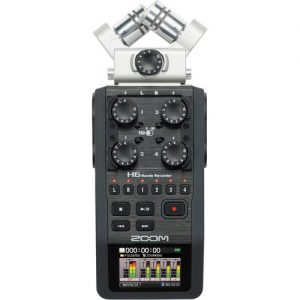Podcaster’s Buyer’s Guide
There is so much information on this subject that I wanted to provide a little breakdown of the concepts and my recommendations for items to get you started.
Microphones
The first thing you need to record a podcast is a microphone, and no your phone won’t do. Sound quality matters a great deal when that’s all you have. If you’ve ever looked what microphone to buy, you may have noticed that it gets large pretty fast. Allow me to break some of it down for you.
One of the first decisions you’ll face, even if you don’t know it at the time, is whether you get a condenser microphone or one that is dynamic.
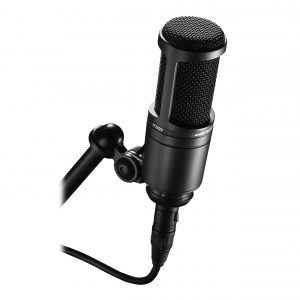
Pictured: An Audio Technica AT2020, a very good and inexpensive microphone that comes up all the time on ‘best mics for podcasting’ lists.
Summary: I personally, advise against my clients buying condensers for podcasting because people very rarely have a good location for recording when they are in an informal setting. This tends to result in recordings with lots of room noise and an unwelcome echoey boomy quality unless great care has been taken to dampen the area. (More often than not, this means sitting in a walk in wardrobe surrounded by clothes).
Dynamic microphones are far less sensitive and so you need to have them much closer to your mouth. They also require a lot more power or gain to drive them effectively. They are very good choices for podcast recording in places that aren’t studios because they don’t pick up the background noise very well and are so much more forgiving for inopportune recording spots.
Pictured: A Shure SM7B, A very good but very expensive mic at this stage that is so common for podcasts that it is virtually a status symbol. Very good at not picking up background noise. Requires very high gain to drive it (meaning a good quality audio interface or a cloudlifter if you want to get into the weeds).
Summary: In my experience, dynamic mics are nearly always desirable to go with for podcast recording outside of a studio environment. Reducing the background noise recorded goes a long way to making something sound good in most scenarios.
USB or XLR
The next major decision to make is whether to use a USB mic or a XLR mic. In order to make that decision I’ll explain some of the considerations.
USB Microphones:
These are great options if you are planning to record remotely and only remotely.
XLR Microphones
These have the widest choice and the greatest flexibility
USB Mic: Pros
- Ease. If you use a USB mic you can plug it into your computer and get started in minutes.
- There are many great options that are made especially for podcasting as USB mics are nearly always used for this.
- Works out cheaper as you do not need to buy an audio interface. (See below).
USB Mic: Cons
- A USB mic isn’t versatile.
- The reason you don’t need to buy an audio interface is because the USB mic has one inside it. This matters because you can only use one interface into your computer at a time. So if you ever decide to do a round-table podcast episode, you can’t use USB mics because you can’t plug every one into one computer.
XLR Mic: Pros
- Choice. XLR connections have been used for decades and you have a huge range of options.
- Quality. The higher quality mics are often only available in XLR.
- Versitlity. Can be plugged into any audio interface or mixing desk along with any other mics.
- Allows you to use great podcast recorders, such as the Rodecaster Pro II.
XLR Mic: Cons
- Require a seperate audio interface or recorder to plug into. More stuff = more setup.
- Expensive when you consider cost of interface
 Hybrid XLR and USB
Hybrid XLR and USB
In the past few years, audio companies have started making mics that have both options. Not so long ago there weren’t too many options for these, but that seems to be changing which is great news. This gives you the best of both worlds, so I would recommend going with one of these.
Here are some recommendations to get you started:
* These are my own views and I have no vested interests to declare.
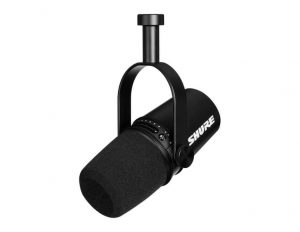
Dynamic I’m not going to get into detailed reviews, there are other’s much better placed to do that. Google is your friend. Let me just say that Shure is a very good brand that’ve made some of the most iconic mics in the world, and their SM7B (see above) is a classic mic and the go to mic for podcasters. Renown for its ability to block out background noise and sound great for the voice. It is also expensive, needs high gain, and XLR only.
The MV7 is a much newer mic that has hybrid connections. So you don’t have to choose between USB and XLR.
It’s still not cheap, but the other thing Shure mics are famous for, is being built to last.
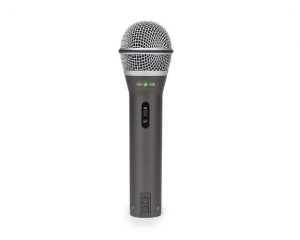
Dynamic. For a long time these have been my go-to recommendation for people looking to get started podcasting. For the powerful combination of being decent sounding and having hybrid USB/XLR.
They do seem to go out of stock a bit and their price fluctuates, but they are hard to beat if you can find them at the right time.
If you are just dipping your toe in, these are a great place to start. They are often sold bundled with a flimsy tripod to make it even easier to get up and running.
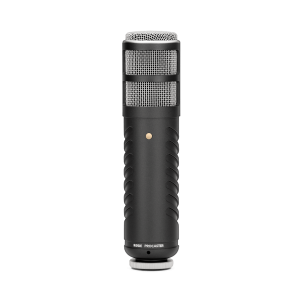
Dynamic. Rode is another giant in the microphone game. They are also an Australian company so I love them even more.
This is fantastic mic that I have been using for years. It is great for the spoken voice (as it should be), it is built incredibly solidly and I have no trouble recommedning it to anyone. It is also an XLR mic so, as you now understand, I need to use a seperate recorder.
They also have a USB version which is also supposed to be excellent.
If you haven’t noticed, all of the above microphones are marketed as podcast microphones, this means that their frequency range is tailored to be good at picking up the voice and not good at stuff outside that range. This means most voices sound good going into the mic without having to do much post production. Importantly, you do not have to buy a mic that is a special podcast mic.
Audio Interfaces & Audio Recorders
Another pretty big topic, but I will try and keep it simple.
These come in many shapes and sizes but the concept is the same. An audio interface is the tool that receives an audio signal and gets it into the computer. Most commonly, this is an analogue signal, such as your voice going into a microphone, going into the interface and getting turned into ones and zeros. They often have several inputs for different instruments and voices and outputs for you headphones and speakers. These can be very cheap all the way to hugely expensive but the concept is the same.
For the purposes of this discussion in the 21st century, an audio recorder is the same thing, only it doesn’t need a computer, instead you record to an SD card… but here’s the trick, these days, an audio recorder can also be used as an interface. I know, right, what a time to be alive?
So, with that in mind, I think it is safe to say, there is no good reason to get an audio interface that isn’t a recorder too. The other assumption, I’m going to make on your behalf, is there is no reason to get an interface or a recorder that isn’t capable of recording 4 microphones at once. Even If you only have two people on your show, you may well have a guest sometime, right? Good.
So, with that in mind, for the purpose of podcasting, you really don’t need to to go too much further than a couple of stalwarts that come up again and again.
Here are my recommendations for an audio interface that’s also a recorder
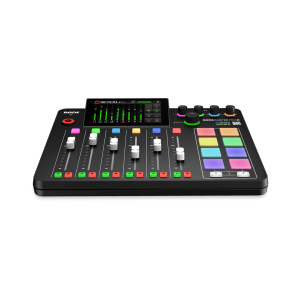
This is, basically, a mini version of one of the broadcast desks you see at the radio stations. Again, I don’t want to get too far into the world of reviewing, but this does thing does more or less everything you could want. You can plug four mics in, load in sounds, ride the faders like a pro, and record onto an SD card. Or if you prefer, you can use it as an interface and record into your computer.
So you can use XLR mics, record remotely, it’s portable should you need it to be etc.
More than enough: Zoom H6
This thing is a quarter of the size, half the price, and can do most of what the Rodecaster can do. You can also record four XLR mics, and you can record onto SD and use it as interface if you need.
It is also not as user friendly and you won’t feel like a radio host operating it. However it is a great option that will do everything you need to get great sound and a professional sounding podcast either remotely or in person.
It’s also going to be much easier to transport. If also comes with two fantastic condenser mics on the top that you can use to record meetings, bird song, you name it.

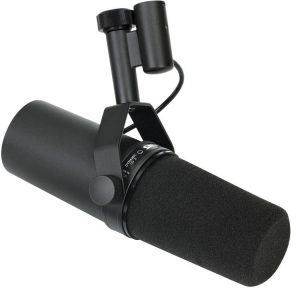
 Hybrid XLR and USB
Hybrid XLR and USB